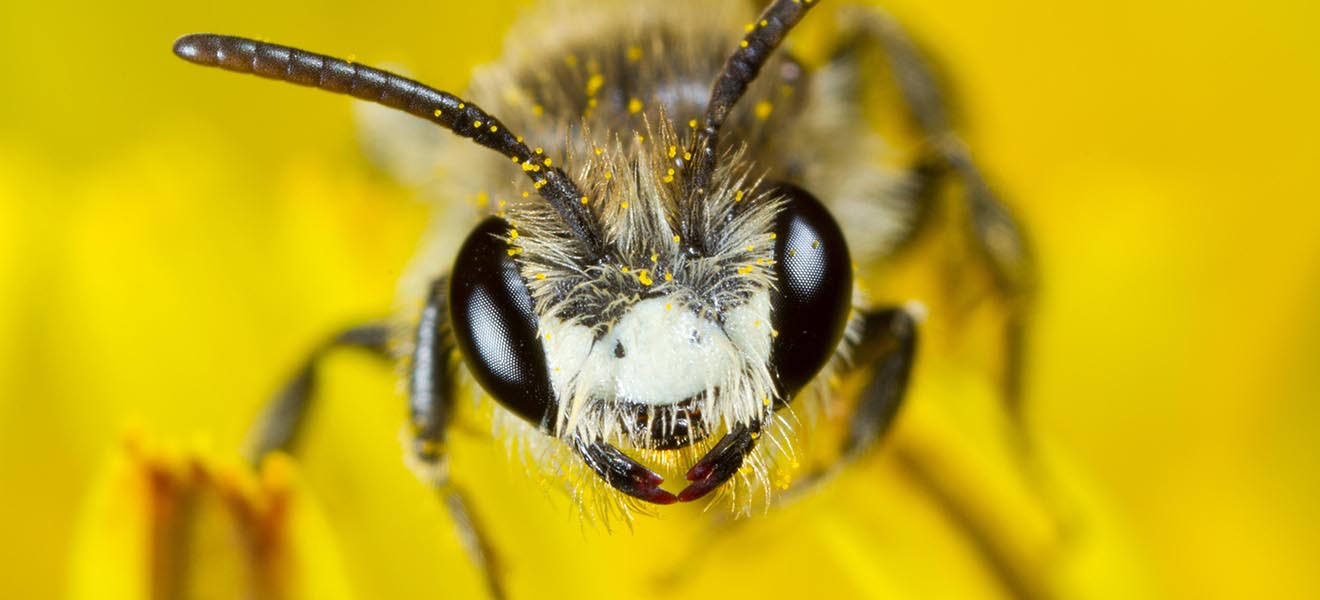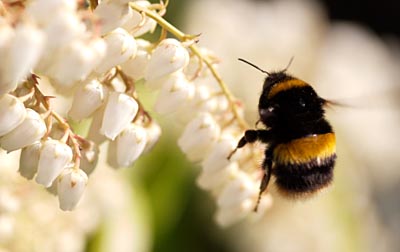How to attract bees to your garden
Dave Goulson, Professor of Biological Sciences at the University of Sussex and founder of the Bumblebee Conservation Trust, explains how to attract bees to your garden.


My interest in bumblebees and other insects dates back to the age of seven. I didn't much care about school, but I loved our new house and it had a much bigger garden than I was used to. There were large flower borders, apple and damson trees, a pond, two ancient wooden sheds full of cobwebs and vast spiders, and enough room for my father to grow a fine patch of vegetables.
My father wasn't too interested in flowers; he allowed me to plant what I liked, so I put in lavender, buddleia and catmint to attract bumblebees and butterflies. I trained honeysuckle up one of the old sheds to feed moths, and planted a male pussy willow to provide the bees with early spring food. I built a large rockery out of old bricks which I scavenged from a dilapidated farm building across the fields, carrying them home in a knapsack. I left spaces at the bottom for the bumblebees to nest in, and planted the top with bird's-foot trefoil to provide flowers for bees and tasty leaves for caterpillars of the common blue butterfly. I dug a bigger pond, and stocked it with newts, stickle-backs and all manner of other beasts from the local canal.
By the following spring, my efforts to encourage wildlife in the garden were really beginning to pay off. I noticed huge queen bumblebees, fresh from hibernation, feeding on the pussy willow and lungwort. These bees had been asleep for seven months or so, since the previous July, so the spring feast I had grown for them was particularly welcome.
As summer approached, the garden began to swarm with wildlife. The buddleia was covered with small tortoiseshells, peacock butterflies, large and small whites, hoverflies and bumblebees. Pond-skaters and whirligig beetles fought territorial battles on the surface of my new pond, and an emperor dragonfly took up residence, perching on a tall purple loosestrife growing in the pond margin. It would zoom out to catch other flying insects to eat, snatching them mid-air with its bristly legs, and chase away any other dragonflies that tried to move in on its patch. I remain to this day amazed at how quickly wildlife appears in a garden if given just a little encouragement.
Bumblebees are surely among the most gentle and friendly of insects. When visiting flowers in the garden, they are placid and simply fly away if disturbed by a human or another bee. Unlike wasps or honeybees, most bumblebees don't even seem to mind very much if you poke around their nest, stinging only as a last resort. Moreover, they are highly social creatures, with the daughters working together with their mother to look after their young and to gather food. Philosophers and writers from Aristotle and Plato to Shakespeare and Marx have used bee societies as a model example against which humans are regarded as comparing poorly.

Bumblebees seem to be doing pretty well in urban areas compared with the countryside, probably because there tend to be more flowers and nesting opportunities in gardens than in farmland. However, there is plenty of room for improvement. Modern bedding plants have been intensively selected for size and colour, and in so doing have lost their nectar, or become grossly misshapen or oversized so that it is impossible for bees to get the rewards. As an example, the small, delicate wild pansy is popular with bumblebees, while the huge showy blooms of cultivated pansies are ignored. So-called ‘F1 hybrids' are often sterile, having no pollen.
‘Double' varieties have extra petals, which prevent bees from getting into the flower. For these reasons, most of the busy lizzies, lobelias, petunias, begonias and so on that are sold in spring to provide an instant splash of colour are more or less useless to bees or butterflies; they have lost their original function, which was to attract pollinators.
Sign up for the Country Life Newsletter
Exquisite houses, the beauty of Nature, and how to get the most from your life, straight to your inbox.
In general, old-fashioned cottage-garden perennials are the ones to go for, particularly garden herbs-lupins, hollyhocks, scabious, lavender, chives, sage, thyme and rosemary and so on. Most are easy to grow and low maintenance so they are well suited to busy modern lifestyles. They are also beautiful; a wildlife-friendly garden does not have to be a chaotic mass of nettles and brambles.
Dave Goulson is Professor of Biological Sciences at the University of Sussex and founder of the Bumblebee Conservation Trust (www.bumblebeeconservation.org). Extracted from ‘A Sting in the Tale', by Dave Goulson, published in 2013 by Jonathan Cape (£16.99)
Country Life is unlike any other magazine: the only glossy weekly on the newsstand and the only magazine that has been guest-edited by HRH The King not once, but twice. It is a celebration of modern rural life and all its diverse joys and pleasures — that was first published in Queen Victoria's Diamond Jubilee year. Our eclectic mixture of witty and informative content — from the most up-to-date property news and commentary and a coveted glimpse inside some of the UK's best houses and gardens, to gardening, the arts and interior design, written by experts in their field — still cannot be found in print or online, anywhere else.
-
 Two quick and easy seasonal asparagus recipes to try this Easter Weekend
Two quick and easy seasonal asparagus recipes to try this Easter WeekendAsparagus has royal roots — it was once a favourite of Madame de Pompadour.
By Melanie Johnson
-
 Sip tea and laugh at your neighbours in this seaside Norfolk home with a watchtower
Sip tea and laugh at your neighbours in this seaside Norfolk home with a watchtowerOn Cliff Hill in Gorleston, one home is taller than all the others. It could be yours.
By James Fisher